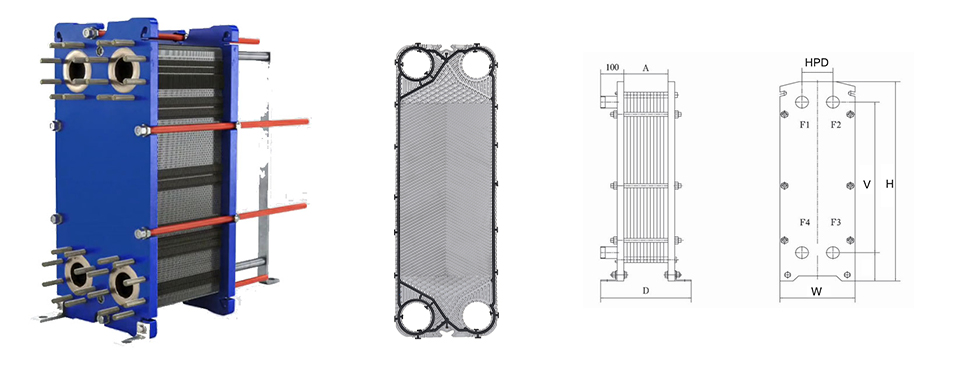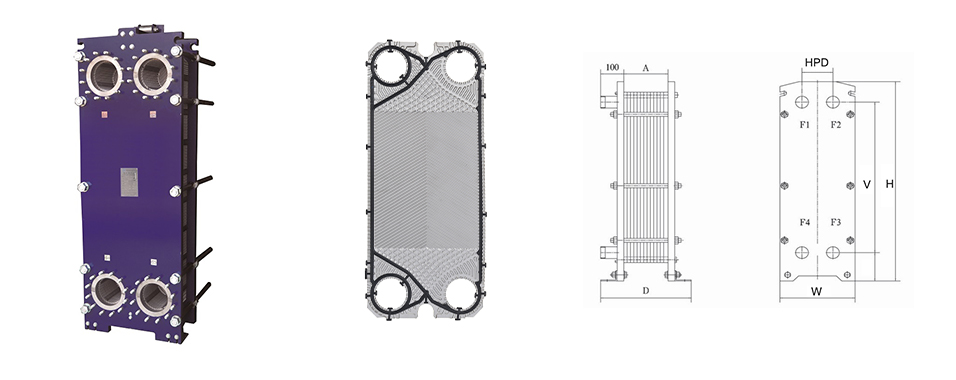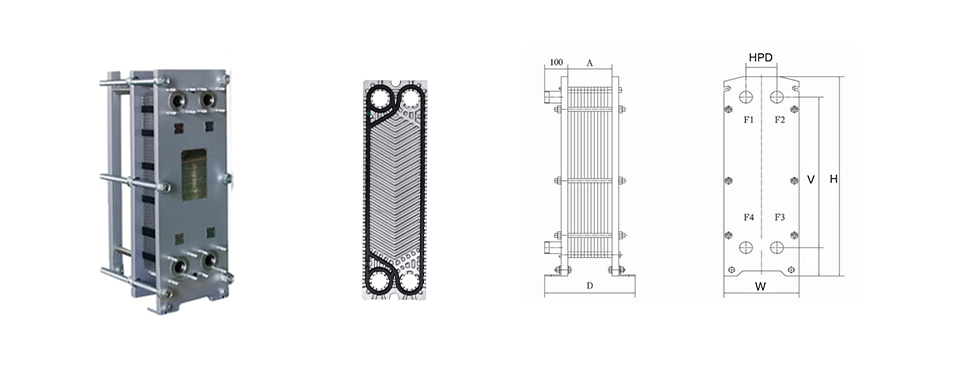Anti-Scaling Treatment of Plate Heat Exchanger
After the heat exchanger runs for a certain time, a layer of white scaling is generated inside and outside the wall of the heat exchanger. The main reason is that the calcium and magnesium salts with small solubility in water, featuring that its solubility declines with the water temperature rising and then it becomes insoluble. The existence of this salt has the following effects on the heat exchanger:
1. The scale has poor thermal conductivity, 150 times smaller than that of the steel. It will lead to heat transfer performance degradation of the heating surface and the ideal temperature drop cannot be achieved. According to the relevant information, for each 1mm-thick layer of scale, the efficiency of the heat exchanger will decrease by about 10%.
2. Scale adhered to the heat transfer surface is difficult to remove, which increases the maintenance cost. Not only it costs a large number of manpower and material resources, but also causes damage to the heating surface, thus reducing the lifetime.
3. The scale reduces the flow section and increases the flow resistance of circulating water inside and outside the heat transfer surface. In severe cases that the flow section is so small or even completely blocked, the heat exchanger cannot operate normally.
Several measures are taken by the design or operation units in order to avoid the problems above, such as chemical softening treatment, magnetic and ion-stick anti-scaling water treatment, and sodium ion exchange treatment. To facilitate further understanding of these softening processes, the principle, formula and operation methods of these treatment measures are respectively introduced as follows:
Chemical softening treatment
Chemical softening treatment is a practical anti-scaling water treatment method, featuring simple operation, high efficiency, good economy and no necessary specialized water equipment. For different methods of dosing chemicals, there are two kinds of treatment methods: calibrator and anti-scaling agent treatment.
1. Common calibrator
Common calibrators include NaOH, Na2CO3 and NaHCO3. The permanent hardness in the water reacts with them and generates sludge, which prevents the production of sulfate scale. Thus the calibrator in water can adjust the effect of permanent hardness.
2. Common anti-scaling agent
The common anti-scaling agent is a mixture of Category I calibrator and the materials such as TSP and tannin extract. After the dissociation in water, the free CO32- and PO43- react with the salt of water hardness and generate sludge, not scale. In the circulating water system, always maintaining moderate amount of CO32- and PO43- is necessary. Even if the water quality changes (the content of permanent hardness increases), the anti-scaling agents like TSP and tannin extract can still play a role in preventing scale.
In the case of the water supply with high permanent hardness, low temporary hardness and the calculated hardness of not more than 3 ~4mmol/l, generally, take circulating water system treatment by using calibrator.
Magnetic Treatment
The principle is to use the molecule polarity of water, namely, the water molecule is covalent compound. Molecules of water polymerize into bimolecular association (H2O)2 or multi-molecular association (H2O)n under the effect of polarity and hydrogen bonds. When the current passes through high-intensity magnetic field, the original multi-molecular association is disassociated into singular or short bonding associations under the external magnetic field, and they cut magnetic induction lines vertically in a certain speed, which generate induced current. Therefore, each ion creates a new magnetic field in the same direction as the external magnetic field, and the adjacent polar ions or molecules in mutual compression and attraction change the crystallization conditions, under which the crystals are slack and fragile, poor in compressive and tensile strength, and weak in cohesive force and adhesive power, thus they are not easy to form scale on the heating surface.
Under the action of the external magnetic field, the changes in ions in water are as follows:
1. External magnetic field causes the water molecule to produce the magnetic moment. The water molecular associations opposite to the external magnetic field rotate and collide and then result in the disassociation of the multi-molecular association, which decreases the average association degree of water molecule.
2. As the average association of water molecules decreases, the solubility of calcium and magnesium salt in water increases, so the crystals such as CaCO3 and CaSO4 are separated out at higher temperatures. Even for the crystals separated out in high concentrations, the particles are also loose.
3. The magnetic field of Ca2+ and Mg2+ is disorganized when there is no external magnetic field. The adjacent magnetic fields generated by ions cancel each other out and maintain a neutral state, under which the small and dense crystals are formed. Under the action of external magnetic field, the magnetic field of Ca2+ and Mg2+ is changed with the direction of the external magnetic field, destroying the original electrostatic attraction state between ions and changing the crystallization conditions. In such conditions, the amorphous crystals formed are fragile and easy to remove.
Ion-Stick Anti-Scaling Water Treatment
Ion-stick anti-scaling water treatment is new and advanced water treatment equipment.
The operating principle is as follows:
(1) Under the direct effect of the 8500V high-voltage static electrostatic field, the ion-stick changes electronic structure of water molecule, and the water dipoles surround the cations and anions then arrange them in positive-and-negative chains, so that the ions will not be free to move and the cations will not tend to move towards the wall, which prevents the calcium and magnesium ions from forming scale on the wall, so as to achieve the purpose of anti-scaling.
(2) Static electricity in the scaling system can destroy the electronic binding force between molecules, change the crystal structure, decompose the scale, increase the dipole moment of water dipole, and enhance the hydration ability with the salt ions, thus increase the dissolution rate of scale, and then the existing scale can be gradually corroded, so as to achieve the purpose of descaling.
Metal corrosion can be prevented for reactive oxygen can generate thin oxidation film on the metal surface of the scale-free system.
1. The scale has poor thermal conductivity, 150 times smaller than that of the steel. It will lead to heat transfer performance degradation of the heating surface and the ideal temperature drop cannot be achieved. According to the relevant information, for each 1mm-thick layer of scale, the efficiency of the heat exchanger will decrease by about 10%.
2. Scale adhered to the heat transfer surface is difficult to remove, which increases the maintenance cost. Not only it costs a large number of manpower and material resources, but also causes damage to the heating surface, thus reducing the lifetime.
3. The scale reduces the flow section and increases the flow resistance of circulating water inside and outside the heat transfer surface. In severe cases that the flow section is so small or even completely blocked, the heat exchanger cannot operate normally.
Several measures are taken by the design or operation units in order to avoid the problems above, such as chemical softening treatment, magnetic and ion-stick anti-scaling water treatment, and sodium ion exchange treatment. To facilitate further understanding of these softening processes, the principle, formula and operation methods of these treatment measures are respectively introduced as follows:
Chemical softening treatment
Chemical softening treatment is a practical anti-scaling water treatment method, featuring simple operation, high efficiency, good economy and no necessary specialized water equipment. For different methods of dosing chemicals, there are two kinds of treatment methods: calibrator and anti-scaling agent treatment.
1. Common calibrator
Common calibrators include NaOH, Na2CO3 and NaHCO3. The permanent hardness in the water reacts with them and generates sludge, which prevents the production of sulfate scale. Thus the calibrator in water can adjust the effect of permanent hardness.
2. Common anti-scaling agent
The common anti-scaling agent is a mixture of Category I calibrator and the materials such as TSP and tannin extract. After the dissociation in water, the free CO32- and PO43- react with the salt of water hardness and generate sludge, not scale. In the circulating water system, always maintaining moderate amount of CO32- and PO43- is necessary. Even if the water quality changes (the content of permanent hardness increases), the anti-scaling agents like TSP and tannin extract can still play a role in preventing scale.
In the case of the water supply with high permanent hardness, low temporary hardness and the calculated hardness of not more than 3 ~4mmol/l, generally, take circulating water system treatment by using calibrator.
Magnetic Treatment
The principle is to use the molecule polarity of water, namely, the water molecule is covalent compound. Molecules of water polymerize into bimolecular association (H2O)2 or multi-molecular association (H2O)n under the effect of polarity and hydrogen bonds. When the current passes through high-intensity magnetic field, the original multi-molecular association is disassociated into singular or short bonding associations under the external magnetic field, and they cut magnetic induction lines vertically in a certain speed, which generate induced current. Therefore, each ion creates a new magnetic field in the same direction as the external magnetic field, and the adjacent polar ions or molecules in mutual compression and attraction change the crystallization conditions, under which the crystals are slack and fragile, poor in compressive and tensile strength, and weak in cohesive force and adhesive power, thus they are not easy to form scale on the heating surface.
Under the action of the external magnetic field, the changes in ions in water are as follows:
1. External magnetic field causes the water molecule to produce the magnetic moment. The water molecular associations opposite to the external magnetic field rotate and collide and then result in the disassociation of the multi-molecular association, which decreases the average association degree of water molecule.
2. As the average association of water molecules decreases, the solubility of calcium and magnesium salt in water increases, so the crystals such as CaCO3 and CaSO4 are separated out at higher temperatures. Even for the crystals separated out in high concentrations, the particles are also loose.
3. The magnetic field of Ca2+ and Mg2+ is disorganized when there is no external magnetic field. The adjacent magnetic fields generated by ions cancel each other out and maintain a neutral state, under which the small and dense crystals are formed. Under the action of external magnetic field, the magnetic field of Ca2+ and Mg2+ is changed with the direction of the external magnetic field, destroying the original electrostatic attraction state between ions and changing the crystallization conditions. In such conditions, the amorphous crystals formed are fragile and easy to remove.
Ion-Stick Anti-Scaling Water Treatment
Ion-stick anti-scaling water treatment is new and advanced water treatment equipment.
The operating principle is as follows:
(1) Under the direct effect of the 8500V high-voltage static electrostatic field, the ion-stick changes electronic structure of water molecule, and the water dipoles surround the cations and anions then arrange them in positive-and-negative chains, so that the ions will not be free to move and the cations will not tend to move towards the wall, which prevents the calcium and magnesium ions from forming scale on the wall, so as to achieve the purpose of anti-scaling.
(2) Static electricity in the scaling system can destroy the electronic binding force between molecules, change the crystal structure, decompose the scale, increase the dipole moment of water dipole, and enhance the hydration ability with the salt ions, thus increase the dissolution rate of scale, and then the existing scale can be gradually corroded, so as to achieve the purpose of descaling.
Metal corrosion can be prevented for reactive oxygen can generate thin oxidation film on the metal surface of the scale-free system.








